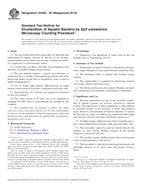Potřebujeme váš souhlas k využití jednotlivých dat, aby se vám mimo jiné mohly ukazovat informace týkající se vašich zájmů. Souhlas udělíte kliknutím na tlačítko „OK“.
ASTM E1295-01(2013)
Standard Guide for Conducting Three-Brood, Renewal Toxicity Tests with Ceriodaphnia dubia
Automaticky přeložený název:
Standardní příručka pro dirigování Byt Brood, obnovení zkoušky toxicity s Ceriodaphnia dubia
NORMA vydána dne 1.3.2013
Informace o normě:
Označení normy: ASTM E1295-01(2013)
Poznámka: NEPLATNÁ
Datum vydání normy: 1.3.2013
Kód zboží: NS-41165
Počet stran: 20
Přibližná hmotnost: 60 g (0.13 liber)
Země: Americká technická norma
Kategorie: Technické normy ASTM
Kategorie - podobné normy:
Anotace textu normy ASTM E1295-01(2013) :
Keywords:
Ceriodaphnia dubia, Cladocera, effluent, life cycle, test material, three-brood toxicity test, ICS Number Code 07.100.20 (Microbiology of water)
Doplňující informace
| Significance and Use | |||||||||||||||||||||||||||||||||||||||||||||||||||||||||||||||||||||||||||||||||||||||||||||||||||||||||||||||||||||||||||||||||
|
5.1 Ceriodaphnia was first used as a toxicity test organism by Mount and Norberg 5.2 Protection of a population requires prevention of unacceptable effects on the number, weight, health, and uses of the individuals of that species, or species for which the test species serves as a surrogate. A three-brood toxicity test is conducted to help determine changes in survival and the number of neonates produced that result from exposure to the test material. 5.3 Results of three-brood toxicity tests with 5.4 Results of three-brood toxicity tests with 5.5 Results of three-brood toxicity tests with 5.5.1 A 48 or 96-h EC50 or LC50 can sometimes be obtained from a three-brood toxicity test with a known test material, but often all the concentrations in the test will be below the EC50 or LC50. In addition, it is usually desirable to know the EC50 or LC50 before beginning the three-brood test, as a means to determine the concentrations for use in the chronic test (see 5.6 Three-brood toxicity tests with 5.7 Results of three-brood toxicity tests with 5.8 Results of three-brood toxicity tests with 1.1 This guide describes procedures for obtaining data concerning the adverse effects of an effluent or a test material (added to dilution water, but not to food) on 1.2 These procedures are applicable to most chemicals, either individually or in formulations, commercial products, or known mixtures, that can be measured accurately at the necessary concentrations in water. With appropriate modifications these procedures can be used to conduct tests on temperature, dissolved oxygen, pH, and on such materials as aqueous effluents (see also Guide E1192), leachates, oils, particulate matter, sediments (see also Guide E1383), and surface waters. Renewal tests might not be applicable to materials that have high oxygen demand, are highly volatile, are rapidly biologically or chemically transformed, or sorb to test chambers. If the concentration of dissolved oxygen falls below 4 mg/L or the concentration of test material decreases by more than 20 % in test solution(s) between renewals, more frequent renewals might be necessary. 1.3 Other modifications of these procedures might be justified by special needs or circumstances. Results of tests conducted using unusual procedures are not likely to be comparable to results of many other tests. Comparisons of results obtained using modified and unmodified versions of these procedures might provide useful information on new concepts and procedures for conducting three-brood toxicity tests with 1.4 This standard does not purport to address all of the safety concerns, if any, associated with its use. It is the responsibility of the user of this standard to establish appropriate safety and health practices and determine the applicability of regulatory limitations prior to use. 1.5 This guide is arranged as follows:
|
|||||||||||||||||||||||||||||||||||||||||||||||||||||||||||||||||||||||||||||||||||||||||||||||||||||||||||||||||||||||||||||||||
Podobné normy:
Historická
1.5.2009
Historická
1.5.2009
Historická
1.1.2014
Historická
1.5.2013
Historická
15.8.2014
Historická
1.6.2012



 ASTM D4412-84(2009)..
ASTM D4412-84(2009).. ASTM D4454-85(2009)..
ASTM D4454-85(2009).. ASTM D4455-85(2014)..
ASTM D4455-85(2014).. ASTM D5246-13
ASTM D5246-13 ASTM D5392-14
ASTM D5392-14 ASTM D5465-93(2012)..
ASTM D5465-93(2012)..
 Cookies
Cookies
